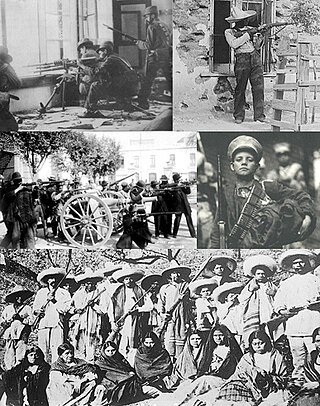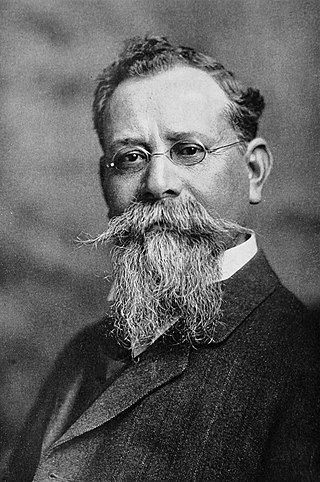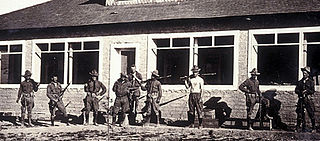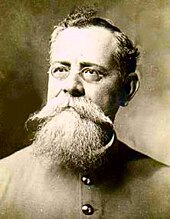
Francisco "Pancho" Villa was a Mexican revolutionary and general in the Mexican Revolution. He was a key figure in the revolutionary movement that forced out President Porfirio Díaz and brought Francisco I. Madero to power in 1911. When Madero was ousted by a coup led by General Victoriano Huerta in February 1913, Villa joined the anti-Huerta forces in the Constitutionalist Army led by Venustiano Carranza. After the defeat and exile of Huerta in July 1914, Villa broke with Carranza. Villa dominated the meeting of revolutionary generals that excluded Carranza and helped create a coalition government. Emiliano Zapata and Villa became formal allies in this period. Like Zapata, Villa was strongly in favor of land reform, but did not implement it when he had power. At the height of his power and popularity in late 1914 and early 1915, the U.S. considered recognizing Villa as Mexico's legitimate authority.

The Mexican Revolution was an extended sequence of armed regional conflicts in Mexico from 20 November 1910 to 1 December 1920. It has been called "the defining event of modern Mexican history". It resulted in the destruction of the Federal Army and its replacement by a revolutionary army, and the transformation of Mexican culture and government. The northern Constitutionalist faction prevailed on the battlefield and drafted the present-day Constitution of Mexico, which aimed to create a strong central government. Revolutionary generals held power from 1920 to 1940. The revolutionary conflict was primarily a civil war, but foreign powers, having important economic and strategic interests in Mexico, figured in the outcome of Mexico's power struggles; the U.S. involvement was particularly high. The conflict led to the deaths of around one million people, mostly noncombatants.

José Venustiano Carranza de la Garza was a Mexican land owner and politician who served as President of Mexico from 1917 until his assassination in 1920, during the Mexican Revolution. He was previously Mexico's de facto head of state as Primer Jefe of the Constitutionalist faction from 1914 to 1917, and previously served as a senator and governor for Coahuila. He played the leading role in drafting the Constitution of 1917 and maintained Mexican neutrality in World War I.

The Pancho Villa Expedition—now known officially in the United States as the Mexican Expedition, but originally referred to as the "Punitive Expedition, U.S. Army"—was a military operation conducted by the United States Army against the paramilitary forces of Mexican revolutionary Francisco "Pancho" Villa from March 14, 1916, to February 7, 1917, during the Mexican Revolution of 1910–1920.

Juan Nepomuceno Cortina Goseacochea, also known by his nicknames Cheno Cortina, the Red Robber of the Rio Grande and the Rio Grande Robin Hood, was a Mexican rancher, politician, military leader, outlaw and folk hero. He was an important caudillo, military general and regional leader, who effectively controlled the Mexican state of Tamaulipas as governor. In borderlands history he is known for leading a paramilitary mounted Mexican Militia in the failed Cortina Wars. The "Wars" were raids targeting Anglo-American civilians whose settlement Cortina opposed near the several leagues of land granted to his wealthy family on both sides of the Rio Grande. Anglo families began immigrating to the Lower Rio Grande Valley after the Mexican Army was defeated by the Anglo-Mexican rebels of the Mexican State of Tejas, in the Texas Revolution.

In the history of Mexico, the Plan of Guadalupe was a political manifesto which was proclaimed on March 26, 1913, by the Governor of Coahuila Venustiano Carranza in response to the reactionary coup d'etat and execution of President Francisco I. Madero, which had occurred during the Ten Tragic Days of February 1913. The manifesto was released from the Hacienda De Guadalupe, which is where the Plan derives its name, nearly a month after the assassination of Madero. The initial plan was limited in scope, denouncing Victoriano Huerta's usurpation of power and advocating the restoration of a constitutional government. In 1914, Carranza issued "Additions to the Plan of Guadalupe", which broadened its scope and "endowed la Revolución with its social and economic content." In 1916, he further revised the Plan now that the Constitutionalist Army was victorious and revolutionaries sought changes to the 1857 Constitution of Mexico. Carranza sought to set the terms of the constitutional convention.
In Mexican history, a plan was a declaration of principles announced in conjunction with a rebellion, usually armed, against the central government of the country. Mexican plans were often more formal than the pronunciamientos that were their equivalent elsewhere in Spanish America and Spain. Some were as detailed as the United States Declaration of Independence. Some plans simply announced that the current government was null and void and that the signer of the plan was the new president.

The United States involvement in the Mexican Revolution was varied and seemingly contradictory, first supporting and then repudiating Mexican regimes during the period 1910–1920. For both economic and political reasons, the U.S. government generally supported those who occupied the seats of power, but could withhold official recognition. The U.S. supported the regime of Porfirio Díaz after initially withholding recognition since he came to power by coup. In 1909, Díaz and U.S. President Taft met in Ciudad Juárez, across the border from El Paso, Texas. Prior to Woodrow Wilson's inauguration on March 4, 1913, the U.S. Government focused on just warning the Mexican military that decisive action from the U.S. military would take place if lives and property of U.S. nationals living in the country were endangered. President William Howard Taft sent more troops to the US-Mexico border but did not allow them to intervene directly in the conflict, a move which Congress opposed. Twice during the Revolution, the U.S. sent troops into Mexico, to occupy Veracruz in 1914 and to northern Mexico in 1916 in a failed attempt to capture Pancho Villa. U.S. foreign policy toward Latin America was to assume the region was the sphere of influence of the U.S., articulated in the Monroe Doctrine. However the U.S. role in the Mexican Revolution has been exaggerated. It did not directly intervene in the Mexican Revolution in a sustained manner.

José Inés Salazar was a Mexican revolutionary general who led the Orozquistas during the Mexican Revolution and later fought with Pancho Villa. He was a native of Casas Grandes, Chihuahua.
The origins of today's Texas Ranger Division trace back to the first days of Anglo-American settlement of what is today the State of Texas, when it was part of the Province of Coahuila y Tejas belonging to the newly independent country of Mexico. The unique characteristics that the Rangers adopted during the force's formative years and that give the division its heritage today—characteristics for which the Texas Rangers would become world-renowned—have been accounted for by the nature of the Rangers' duties, which was to protect a thinly populated frontier against protracted hostilities, first with Plains Indian tribes, and after the Texas Revolution, hostilities with Mexico.

The Mexican Border War, or the Border Campaign, was a series of military engagements which took place in the Mexican–American border region of North America during the Mexican Revolution. The period of the war encompassed World War I, and the German Empire attempted to have Mexico attack the United States, as well as engaging in hostilities against American forces there itself.
The Ojo de Agua Raid was the last important military engagement between Mexican Seditionistas and the United States Army. It took place at Ojo de Agua, Texas. As part of the Plan of San Diego, the rebels launched a raid across the Rio Grande into Texas on October 21, 1915 aimed at harassing the American outposts along the Mexican border and disrupting the local economy. After moving across the border, the Seditionistas began an assault against the United States Army Signal Corps station at Ojo de Agua. The small group of American defenders was cornered into a single building and suffered heavy casualties before reinforcements arrived driving the Seditionist force back into Mexico. The raid proved to be the tipping point in the American conflict with the Seditionistas, as its severity convinced American officials to send large numbers of American troops to the area in order to deter any further serious border raids by the Mexican force.
The Raid onNorias Ranch was an incident in August 1915 in which a large band of Mexican Seditionistas attacked an American ranch in southern Texas. It became one of the many small battles fought on American soil during the Mexican Revolution and resulted in an increased effort by the United States Army to defend the international border. At least seven people were killed in the raid and several more from among those wounded by gunfire may have died immediately afterwards.
The Bandit War, or Bandit Wars, was a series of raids in Texas that started in 1915 and finally culminated in 1919. They were carried out by Mexican rebels from the states of Tamaulipas, Coahuila, and Chihuahua. Prior to 1914, the Carrancistas had been responsible for most attacks along the border, but in January 1915, rebels known as Seditionistas drafted the Plan of San Diego and began launching their own raids. The plan called for a race war to rid the American border states of their Anglo-American population and for the annexation of the border states to Mexico. However, the Seditionistas could never launch a full-scale invasion of the United States and so the faction resorted to conducting small raids into Texas. Much of the fighting involved the Texas Ranger Division, but the US Army also engaged in small unit actions with bands of Seditionist raiders.

The raid on Glenn Springs occurred on the night of May 5–6, 1916, when Mexican Villistas and Carrancistas attacked the towns of Boquillas and Glenn Springs, Texas. In Glenn Springs, the raiders burned several buildings and fought a three-hour battle with a small force of American soldiers who were stationed there. At the same time, a second party of rebels robbed a general store and a silver mine in Boquillas. Four Americans were killed and the rebels took two hostages to Coahuila. In response to the attack, the United States Army launched a short punitive expedition into Mexico, fought with the rebels, and rescued the captives.

The Second Battle of Nogales was a three-sided military engagement of the Mexican Revolution, fought in November 1915 at the border towns of Nogales, Sonora, and Nogales, Arizona. On the morning of November 26, rebel forces of Pancho Villa, who occupied Nogales, Sonora, began firing on United States Army soldiers in Nogales, Arizona. The Americans responded with counter fire for over two hours before a force of Carrancistas arrived to attack the Villistas. Later that day, the Constitutionalistas accidentally opened fire on American soldiers and another short skirmish was fought. The battle resulted in the deaths of several Mexicans and was the first significant engagement fought between Villistas and the United States military.
The Raid onSan Ygnacio refers to a battle fought on June 15, 1916 between the United States Army and Mexican raiders near the border town of San Ygnacio, Texas. Three different Mexican factions were known to have launched raids into Texas at the time but most of the evidence suggests that either Seditionists or Carrancistas were responsible for the incursion. Four American soldiers were killed during the battle, along with at least six of the raiders, and the resulting American punitive expedition further strained the already hostile relationship between the Mexican and United States governments.

1920: America's Great War is an alternate history novel by the Michigan economics professor Robert Conroy. It was first published as an ebook by Baen Books in November 2013. A hardcover edition followed in December of the same year and then a paperback edition in March 2015. The novel depicts a fictional world in which Imperial Germany had emerged victorious early in World War I and launches a surprise invasion of the United States in 1920 from Mexico. The book's premise is based on an actual plan that Germany had proposed to Mexico during the war.

The Porvenir massacre was an incident on January 28, 1918, outside the village of Porvenir, in Presidio County, Texas, in which Texas Rangers and local ranchers, with the support of U.S. Cavalry, killed 15 unarmed Mexican American boys and men. The Texas Rangers Company B had been sent to the area to stop banditry after the Brite Ranch raid. Despite having no evidence that the Porvenir villagers had been involved in recent thefts or the killings of ranchers, the Rangers separated 15 men and boys from the rest of the village and shot them on a nearby hill.
La Matanza and the Hora de Sangre was a period of anti-Mexican violence in Texas, including lynchings and massacres, between 1910 and 1920 in the midst of tensions between the United States and Mexico during the Mexican Revolution. This violence was committed by Anglo-Texan vigilantes, and law enforcement, such as the Texas Rangers, during operations against bandit raids known as the Bandit Wars. The violence and denial of civil liberties during this period was justified by racism. Ranger violence reached its peak from 1915 to 1919, in response to increasing conflict, initially because of the Plan de San Diego, by Mexican and Tejano insurgents to take Texas. This period was referred to as the Hora de Sangre by Mexicans in South Texas, many of whom fled to Mexico to escape the violence. At least 300 Mexican Americans were killed in Texas during the 1910s, with total estimates of ranging from hundreds to thousands killed. At least 100 Mexican Americans were lynched in the 1910s, many in Texas. Many murders were concealed and went unreported, with some in South Texas, suspected by Rangers of supporting rebels, being placed on blacklists and often "disappearing".














